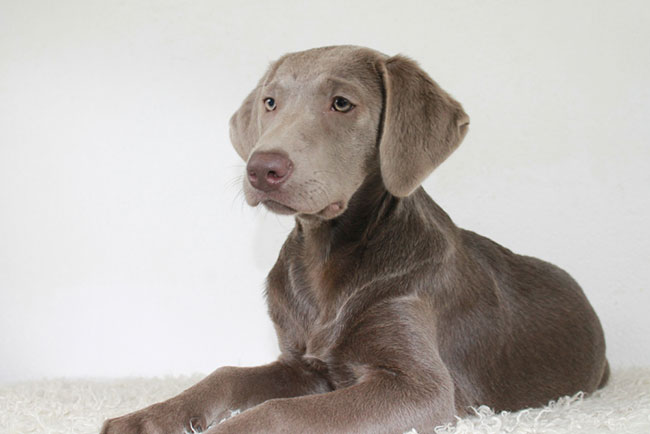
Hey, have you ever seen a Silver Labrador? These pups aren’t your average Labradors—they’re like the unicorns of the dog world! While most Labrador Retrievers come in classic black, yellow, or chocolate, Silver Labs rock a rare, shiny gray coat that makes them stand out like furry celebrities.
Their unique color isn’t just cool—it’s super rare, which is why everyone’s talking about them! But here’s the twist: some people debate whether Silver Labradors are “true” Labradors or have a dash of another breed in their DNA. Either way, they’ve got all the traits that make Labrador Retrievers awesome—they’re loyal, playful, and love adventures, whether it’s splashing in a lake or snoozing on your lap.
From their Instagram-worthy looks to their big-dog energy, Silver Labradors are stealing hearts everywhere. Want to know why they’re such a big deal? Let’s dive in!
What Are Silver Labradors? The Sparkly Dogs Everyone’s Talking About!
Silver Labradors are a type of Labrador Retriever, but they’re not your everyday Lab. Imagine taking a chocolate Labrador and mixing it with a splash of glitter—that’s a Silver Lab! These dogs have a rare silver-gray coat that looks like a stormy sky or shiny metal. Their fur isn’t just cool—it’s caused by something called the “dilution gene”, which works like a magic filter to lighten their color.
What Makes Them Look So Unique?
- Coat Color: Their fur isn’t plain gray—it’s a mix of soft silver and hints of brown, like a melted chocolate bar swirled with milk. This happens because they inherit two copies of the dilution gene (nicknamed “dd”).
- Eyes: Many Silver Labs have striking hazel or amber eyes, which pop against their silvery fur. Some even have lighter eyes than regular Labs, giving them a “mysterious” look.
- Personality: Don’t let their fancy coat fool you—they’re still 100% Labrador! They’re playful and loyal, and they love adventures, whether it’s swimming, fetching, or just cuddling.
Where Did They Come From? A Genetics Mystery!
Silver Labs have caused big debates among dog experts. Here’s the scoop:
- The Dilution Gene: All Labradors carry genes that decide their coat color. Most are black, yellow, or chocolate. But Silver Labs have a rare “dd” gene combo that lightens their fur.
- The Controversy: Some folks think Silver Labs must be mixed with Weimaraners (a sleek gray hunting dog) because that breed naturally has the “dd” gene. Others argue the gene popped up naturally in Labradors long ago.
- History Twist: The first Silver Labs appeared in the 1950s. Breeders who loved both Labradors and Weimaraners started selling them, which made people suspicious. But DNA tests today often show Silver Labs as “100% Labrador,” even if their family tree is a bit fuzzy.
Why Does This Matter?
While Silver Labs look awesome, their special gene can sometimes cause health issues. For example, Color Dilution Alopecia (CDA) might make their fur thin or itchy. That’s why good breeders test their dogs’ DNA to avoid passing on problems.
Fun Fact: The AKC (the big dog registry) calls Silver Labs “light chocolate” to keep things official. So yes, they’re technically chocolate Labs… just extra sparkly!
So, are Silver Labradors magical mutants or secret mixes? Scientists still aren’t sure. But one thing’s clear: these dogs are here to stay, turning heads and stealing hearts with their shiny coats and goofy grins!
The Silver Labrador Debate: A History Full of Mystery
Let’s travel back in time to unravel the story of Silver Labradors—a tale that’s part science, part drama, and 100% fascinating!
When Did Silver Labs First Appear?
Silver Labradors began grabbing attention in the 1950s when breeders in the United States started producing puppies with shiny silver-gray coats. But here’s the twist: old newspaper ads from as far back as 1902 mention “silver-colored” Labradors in England. This means the silver coat might not be as new as some people think!
At first, these rare dogs confused everyone. Breeders argued: Were they purebred Labradors, or did they have a secret mix of another breed? The debate still isn’t fully settled today.
The Big Controversy: Purebred or Mix?
The main fight centers on the dilution gene—a genetic “light switch” that turns a chocolate Lab’s fur silver. Here’s why people disagree:
1. The Weimaraner Theory
Some experts believe Silver Labs must be mixed with Weimaraners—a sleek gray hunting dog. Why? Because Weimaraners naturally carry the dilution gene (nicknamed “dd”) that creates silver fur. Critics point to breeders in the 1950s who owned both Labradors and Weimaraners. They suspect these breeders secretly mixed the two breeds to create the silver color.
2. The Purebred Argument
Others insist Silver Labs are 100% purebred. They argue the dilution gene has always existed in Labradors but stayed hidden for years. Modern DNA tests (like Embark) often show Silver Labs have no Weimaraner ancestry, which supports this idea. Plus, historical records from England mention silver Labs long before Weimaraners became popular in the U.S..
What Do Kennel Clubs Say?
The American Kennel Club (AKC) lets owners register Silver Labs as “chocolate”—since their fur is technically a light version of brown. However, groups like the Labrador Retriever Club of America refuse to accept silver as an official color, calling it “controversial”.
This disagreement has caused drama in the dog world. Some breeders loudly defend Silver Labs’ purity, while others accuse them of lying about the dogs’ origins.
Why Does This Matter?
The debate isn’t just about fur color—it’s about ethics. Critics worry that breeding for rare colors (like silver) could harm dogs’ health. For example, the dilution gene can sometimes cause Color Dilution Alopecia, a condition that makes fur thin or itchy. Supporters counter that responsible breeders test their dogs’ DNA to avoid passing on problems.
Whether Silver Labradors are purebred or part-Weimaraner might never be fully resolved. What’s clear is that these dogs have won hearts worldwide with their sparkly coats and classic Lab personalities. As one Reddit user put it: “They’re still Labradors—loyal, playful, and obsessed with snacks!”.
So, are they Labradors in disguise or accidental superheroes? Science is still figuring it out. But one thing’s certain: Silver Labs are here to stay, turning walks into fashion shows and stealing treats with style!
Characteristics of Silver Labradors

1. Physical Traits: What Makes Silver Labs Stand Out?
Silver Labradors look a lot like regular Labradors but with one big difference—their shiny silver-gray coat! They’re medium-sized dogs, with males weighing 55–80 pounds and females 45–70 pounds. Their fur is short, thick, and water-resistant, perfect for swimming or playing in the rain. The silver color isn’t magic—it comes from a special gene called the dilution gene (nicknamed “dd”), which lightens their coat from chocolate to silver.
Some Silver Labs have hazel or amber eyes that glow against their silvery fur, giving them a unique look. A few might even have lighter eyes than regular Labradors, adding to their “mysterious” vibe. While most look like typical Labs, some people notice slightly different facial features, like a narrower head, which fuels debates about their origins.
2. Temperament: The Classic Lab Personality
Silver Labradors act just like the Labradors you know and love—they’re loyal, smart, and full of energy! They’re famous for being friendly family dogs who adore playing fetch, swimming, or snoozing on the couch after a long day. Their high energy means they need lots of exercise, like runs, hikes, or games of tug-of-war.
Some owners say Silver Labs are calmer than regular Labs, while others report they’re just as wild and playful. Most agree they’re quick learners and easy to train, whether for tricks, therapy work, or hunting. However, critics argue that breeding for their rare color might affect their temperament, making them less “Lab-like”. But most fans say: “If it acts like a Lab and loves like a Lab, it’s a Lab!”.
Read More: How to Train a Labrador Retriever
3. Health Considerations: What to Watch For
All Labradors can face health issues like ear infections (thanks to their floppy ears), hip dysplasia (a joint problem), or obesity if they eat too much. But Silver Labs have extra risks because of their unique coat gene:
- Color Dilution Alopecia (CDA): This condition, linked to the “dd” gene, can make their fur thin or itchy. Not all Silver Labs get it, but it’s more common in dogs with diluted coats.
- Skin Allergies: Their sensitive skin might react to foods or pollen, causing redness or scratching.
- Inbreeding Risks: Some breeders pair closely related dogs to keep the silver color, raising the chance of epilepsy or thyroid issues.
To keep Silver Labs healthy, owners should:
- Clean their ears weekly to prevent infections.
- Choose high-quality dog food to avoid allergies.
- Pick breeders who test for hip/joint health and avoid “puppy mills” focused only on color.
Key Takeaway:
Silver Labradors share the classic Labrador traits—loyalty, energy, and smarts—but their rare coat comes with unique health considerations. Whether they’re purebred or mixed, their biggest needs are love, exercise, and regular vet check-ups!
How to Care for a Silver Labrador

1. Diet and Nutrition: Fueling Your Lab’s Energy
Silver Labradors love food—sometimes too much! To keep them healthy, feed them high-quality dog food packed with protein, like chicken, fish, or lamb. Labs burn energy quickly, so their meals should fuel their playtime without making them gain weight.
What to feed:
- Puppies (under 1 year): Special puppy food with extra nutrients for growing bodies.
- Adults: Kibble labeled for “active breeds” or “large dogs”. Add fresh veggies like carrots or green beans for extra vitamins.
- Seniors (7+ years): Low-calorie food to avoid joint stress.
Portion control is key!
Labs will eat like vacuums if you let them. Measure meals (ask your vet for the right amount) and avoid too many treats. Some owners add fish oil or eggs to meals for a shiny coat.
2. Exercise Needs: Keeping Your Lab Happy
Silver Labradors are energetic athletes—they need 1–2 hours of exercise daily to stay fit and calm. Without it, they might chew shoes or dig holes out of boredom!
Fun activities:
- Swimming: Their webbed paws make them natural swimmers! It’s easy on their joints and cools them off.
- Fetch: Throw a ball or frisbee in a park.
- Hikes: Let them sniff new trails for mental stimulation.
Puppy rule: For puppies under 1 year, limit walks to 5 minutes per month of age (e.g., 20 minutes at 4 months) to protect growing bones.
3. Grooming Tips: Managing That Silvery Coat
Silver Labradors shed a lot, especially in spring and fall. Here’s how to keep their coat shiny and healthy:
Brushing: Use a rubber brush (like a Kong ZoomGroom) 2–3 times a week to remove loose fur. During shedding season, brush daily to avoid fur piles on your couch!
Bathing: Bathe them every 4–8 weeks with dog shampoo. Avoid human soap—it dries their skin.
Ears & Nails:
- Ears: Clean weekly with a vet-approved wipe to prevent infections.
- Nails: Trim every 2–3 weeks. If you hear clicking on floors, it’s time!
Never shave their coat! Their fur protects them from sunburn and cold. Instead, use a de-shedding tool to thin out extra fluff.
Key Takeaways:
- Food: Quality protein + veggies = happy Lab.
- Exercise: 1–2 hours daily keeps mischief away.
- Grooming: Brush often, bathe monthly, and protect that silver coat!
Silver Labradors thrive with love, playtime, and a little TLC. Treat them right, and they’ll be your loyal best friend for life!
Cost and Availability of Silver Labradors
Why Are Silver Labradors So Expensive?
Silver Labradors are one of the rarest dog breeds in the Labrador family, which makes them pricier than regular Labs. While black, yellow, or chocolate Labs might cost $800–$1,500, Silver Labs often sell for $1,200–$2,500+. Their unique silver-gray coat is in high demand, and breeders know people will pay extra for their “unicorn” look.
What Affects the Price?
- Breeder Reputation:
- Reputable breeders who health-test parents (for hips, eyes, etc.) and offer guarantees charge more—up to $2,200+. Cheaper options might skip health checks, risking issues like allergies or joint problems.
- Coat Color:
- “Charcoal” (dark gray) or “light silver” Labs often cost more than traditional colors.
- Location:
- Prices climb in cities or areas with fewer breeders. For example, Silver Labs in Canada average $1,500–$2,200, while U.S. breeders charge similar rates.
Are They Hard to Find?
Yes! Silver Labs are rare dog breeds, so many breeders have waiting lists. Some require deposits months before puppies are born. Always ask:
- “Can I meet the puppy’s parents?”
- “Are there health guarantees?”
- “Are they AKC-registered?”
Watch Out for Puppy Mills!
Cheap Silver Labs (under $1,000) might come from puppy mills—farms that prioritize profit over dog health. These pups often have hidden issues. Ethical breeders share vet records and DNA tests and let you visit their facilities.
Key Takeaway
Silver Labradors cost more because they’re rare and trendy, but price doesn’t always mean quality. Do your homework: choose breeders who care about health, not just coat color!
Where Can I Find Reputable Breeders?
Finding a good breeder is important to ensure your Silver Lab is healthy and well-cared for. Here’s how to find one:
- Look for breeders who focus on health testing for hips, eyes, and genetic conditions like CDA.
- Avoid breeders who only focus on coat color or sell puppies cheaply—this can be a sign of puppy mills.
- Check if the breeder is registered with organizations like the AKC or local Labrador clubs.
You can also visit dog shows or ask for recommendations from trusted Labrador Retriever groups online. Ethical breeders will answer all your questions and let you meet the puppy’s parents!
Key Takeaways:
- Silver Labs may not be officially recognized as purebred by all organizations due to their unique coat gene.
- They have similar care needs to other Labs but may need extra attention for skin health.
- Always choose reputable breeders who prioritize health over appearance to ensure you get a happy and healthy puppy!
Pros and Cons of Owning a Silver Labrador
Pros:
Silver Labradors are like the superhero version of regular Labs—they come with cool powers and classic charm!
- Unique Looks: Their silver-gray coat turns heads everywhere. Imagine walking a dog that looks like it rolled in glitter! Compared to other Labs, they’re the rarest, making you feel like you own a living treasure.
- Labrador Loyalty: They’ve got all the classic Lab traits: loyal, playful, and great with families. They’ll be your shadow during hikes, your study buddy, and your couch potato pal—all in one!
- Smart & Trainable: Silver Labs learn tricks fast. Teaching them to fetch your socks or high-five? Easy! They’re perfect for first-time dog owners.
If you want a dog that’s both unique and full of love, Silver Labs checks all the boxes.
Cons:
But there’s a catch—owning a rare dog isn’t all sparkles.
- The “Are They Real Labs?” Debate: Some people argue Silver Labs aren’t purebred. You might hear rude comments like, “That’s not a real Labrador.” It isn’t very pleasant, but it’s part of owning a rare breed.
- Health Risks: Their special coat gene can cause skin issues (like thinning fur) or allergies. Vet bills might be higher than for regular Labs.
- Price Tag: Silver Labs cost $1,200–$2,500+—way more than a regular Lab. Plus, finding a good breeder takes time. Cheap options might be puppy mills with sick pups.
How Do They Compare to Other Dogs?
- Vs. Regular Labs: Same awesome personality, but Silver Labs cost more and face more health risks.
- Vs. Weimaraners: Weimaraners have similar gray coats but are more independent. Silver Labs are friendlier and better for families.
- Vs. Designer Breeds (like Labradoodles): Silver Labs are less trendy but have fewer unknown health issues.
Silver Labradors are loyal, unique, and fun—but they come with challenges. If you’re okay with higher costs and occasional debates about their breed, they’re a pawsome choice. Just remember: rare doesn’t always mean better! Do your homework to avoid scams and health troubles.
9. Conclusion
So, what’s the final take on Silver Labradors? Let’s break it down:
Silver Labradors are like the unicorns of the dog world—they’ve got that rare, shiny coat and the same lovable personality as regular Labs. They’re playful, loyal, and perfect for families who love adventures. But here’s the thing: their unique color comes with big debates about their origins and extra responsibilities for owners.
Key Things to Remember
- Looks vs. Reality: That silver coat is cool, but it might mean higher vet bills or skin issues.
- Cost: They’re pricier than regular Labs, and finding a good breeder takes work.
- Controversy: Not everyone agrees they’re “true” Labradors, so be ready for questions (or rude comments!).
Before you decide, ask yourself:
- Can you afford their care for 10–12 years?
- Do you have time for 1–2 hours of daily walks or play?
- Are you okay with brushing fur off your clothes every day?
If you’re up for the challenge, Silver Labradors can be amazing pets. But if you want a lower-maintenance dog, a classic black, yellow, or chocolate Lab might be a better fit.
Bottom line: Silver Labs are awesome, but they’re not magic—they need love, patience, and smart choices. Do your homework, pick a responsible breeder, and get ready for a lifetime of fun with your sparkly new best friend!
FAQ.
Are Silver Labradors Purebred?
Silver Labradors are controversially considered purebred. While the AKC registers them as chocolate Labradors, their silver coat comes from a dilution gene (dd) typically linked to Weimaraners. Genetic studies show mixed results, but most modern Silver Labs exhibit purebred traits despite historical crossbreeding debates.
Do Silver Labradors Have Different Care Needs Compared to Other Labradors?
Silver Labradors need similar care to other Labs but require extra skin checks for Color Dilution Alopecia. Daily exercise (1–2 hours) and weekly brushing manage their energy and shedding. They share the same friendly, playful nature as all Labradors, with no major differences beyond coat-related health monitoring.
Can a silver lab be akc registered?
Yes, silver Labs can be AKC registered, but not as “silver.” The AKC classifies them as chocolate Labradors since their silver color is considered a dilute variation of chocolate. However, many breed experts argue that silver Labs are not purebred due to their suspected Weimaraner ancestry.
When was the first silver lab?
Silver Labs first appeared in the 1950s and were later featured in Gun Dog magazine. Labradors were officially recognized by the AKC in 1917 and in England in 1903, but at that time, most Labradors were black, as it was the preferred coat color among dog enthusiasts.
How rare are silver Labradors?
Silver Labradors aren’t truly rare—they are simply not an official Labrador color. Unlike brindle or black-and-tan Labs, which occur naturally, silver Labs result from the dilute gene and are controversial among breed experts. Reputable breeders typically don’t sell them, as they are not recognized as a standard Labrador color.
Where Can I Find Reputable Breeders?
Find reputable Silver Labrador breeders through AKC-registered sources or local Labrador clubs. Prioritize those health-testing hips, eyes, and Color Dilution Alopecia. Avoid cheap, color-focused sellers (potential puppy mills). Seek referrals from trusted breed groups or vets and ensure breeders allow parent-dog meetings for transparency.
Referece Links:
- Genetic Basis of Coat Color Dilution (MLPH Gene)
Polymorphisms within the canine MLPH gene are associated with dilute coat color in dogs
2005 NCBI study explaining the dilution gene (dd) linked to silver coats and Color Dilution Alopecia. - Labrador Retriever Club’s Official Stance
The Issue of the Silver Labrador
Official position from the AKC parent club, stating silver Labs are not recognized as purebred Labradors. - Causal MLPH Mutation in Dogs
A noncoding MLPH SNP causes coat color dilution in dogs
2007 study identifying the genetic mutation (c.-22G>A) responsible for coat color dilution and associated health risks.



